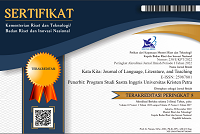THE APOLOGY STRATEGIES IN SIMULATED CLASSROOM SITUATIONS USED BY THE FEMALE AND THE MALE STUDENTS OF THE ENGLISH DEPARTMENT OF PETRA CHRISTIAN UNIVERSITY, SURABAYA
DOI:
https://doi.org/10.9744/katakita.3.4.56-65Keywords:
Business Model Canvas (BMC), Elemen BMC, Model BisnisAbstract
This thesis is the study of apology strategies and the similarities and/or the differences of the types of apology strategies used by the female and the male students. My respondents consist of 20 female and 20 male students of the English Department. This study used the theory of Ogiermann (2009). I constructed my own Discourse Completion Test (DCT) questionnaire consisting of 10 simulated classroom situations. The quantitative approach was used in this study. The finding revealed that the first three most dominant types of strategies used by the both of them were expression of regret, acceptance of responsibility and justification. The similarities and/or the differences of the three most dominant types of apology between the female and the male students were found in the percentage use of apology strategies. Expression of regret was used 52.8% by the female students and 47% by the male students. The female students used 53.3% and the male students used 46.6% in acceptance of responsibility. Justification was used 52.7% by the female and 47.3% by the male students. For that reason, the female and the male students tend to use the same types of apology strategies, although their percentages are only slightly different.
References
Alfattah, M. H. A. (2010). Apology strategies of Yemeni EFL University students. The Modern Journal of Applied Linguistics, 2(3), 223 - 249.
Merriam, S. B. (2009). Qualitative Research: A Guide to Design and Implementation. San Francisco: Jossey-Bass.
Ogiermann, E. (2009). On Apologising in Negative and Positive Politeness Cultures. Amsterdam: John Benjamins B. V.
Downloads
Issue
Section
License
Authors who publish with this journal agree to the following terms:- Authors retain copyright and grant the journal right of first publication with the work simultaneously licensed under a Creative Commons Attribution License that allows others to share the work with an acknowledgement of the work's authorship and initial publication in this journal.
- Authors are able to enter into separate, additional contractual arrangements for the non-exclusive distribution of the journal's published version of the work (e.g., post it to an institutional repository or publish it in a book), with an acknowledgement of its initial publication in this journal.
- Authors are permitted and encouraged to post their work online (e.g., in institutional repositories or on their website) prior to and during the submission process, as it can lead to productive exchanges, as well as earlier and greater citation of published work (See The Effect of Open Access).














